

Ultra Deep look at Messier 81 & 82
source link: https://theuberger.ch/post/astrophotography/20230507-m81m82-collab/
Go to the source link to view the article. You can view the picture content, updated content and better typesetting reading experience. If the link is broken, please click the button below to view the snapshot at that time.

Zoomable, full-resolution image (click on the image):

My first international collab!
This is the result of my very first international collab! 15 amateur astronomers contributed their data to this image! Note that the shown full-resolution images on this page were slightly modified by me compared to the original. The main things I have done are applying some Sharpening (BlurXTerminator) and Noise Reduction (NoiseXTerminator). Through this process, some of the scientific value might have been lost in the process. To view the original check out the post on astrobin: (https://www.astrobin.com/tb0sou/)
The target
The galaxy pair Messier 81/82 is a very popular target for astrophotographers as it is fairly easy to image and contains many interesting features, such as IFN (Integrated flux nebula) and faint background galaxies. Additionally, M81 and M82 have been violently gravitationally interacting for almost 1.5 billion years. This gravitational push and pull most likely caused huge amounts of supernovae in M82’s starburst region, which are believed to ultimately fuel M82’s bipolar Ha-outflow.
This bipolar outflow or Ha-stream was also the main focus of our big collaboration! Having been interested in the galaxy pair for a long time, We found several deep images of the region and were especially interested in the H-alpha cap of M82 (See image). What intrigued me about this cap is that there is not really a visible connection between the main outflows of M82 and its cap. However, in some of the deepest images, it is possible to ever so slightly make out a dim connection between the main Ha stream and the Ha cap.
Since there exists no clear image of this region, We wanted to produce an image deep enough to reveal this exact region, which ultimately resulted in the beginning of this amazing collaboration of Astrophotographers from all over the world. In order to reveal the missing piece, we knew we had to go DEEP. Starting in February we had 6 people in the group, but the number quickly rose to now 17 people: 1 Editor, 1 person who gave us his Bortle 1 data for MSGR, and 15 photographers. By mid-April we had 173h 34min of broadband data and 243h 04min of Ha data which had us confident in realizing our goal. With 416h 38min of total integration gathered on the target, of which 393h 10min (or over 16 days) were effectively used, this also marks the longest integration time ever on M81/82, and the longest one-panel integration time on Astrobin!
Before getting into any details in the picture, I want to thank everybody who contributed to this project. It was a pleasure working together with everybody! Hopefully there’s more to come : )
- Carl Björk - @Palmito
- Thomas Bähnck
- Oliver Carter - @Oliver Carter
- Sascha Frei - @Usernamealreadytaken
- Jake Gentillon - @jake_g
- Richard Hall - @Richard
- Tino Heuberger - @RononDex
- Jason Jacks - @jmdl101
- Travis Lecture - @SpaceIsWhack
- Brian Meyers - @Brian M.
- Oskari Nikkinen - @Oskari Nikkinen
- William Ostling - @William Ostling
- Prashant Ranganath - @Prashant Ranganath
- Tim Schaeffer - @Tim Schaeffer
- Mark Shelton - @MARK Shelton
- Felix Schöfbänker - @SomeAstroStuff
- Berengar von Ow
Special thanks to:
- William, our editor and instructor on anything processing related and who also helped compose this text. He spent a staggering 40h+ hours processing the image you see here.
- Carl, who was also a great help in anything technical related and who stacked all of our over 9000+ Broadband files and 3000+ Ha files, which took over 4TB of space and several days/weeks of processing.
- Mark, who stacked all of our 3000+ Ha files which again took several days and gave us a second option for the Ha-stack
- Prashant, who gave us his excellent Bortle 1 data that was used for MSGR
Interesting features in our image
First of all of course the whole Ha stream, being captured by amateurs for the first time ever! After the Ha cap was discovered by Devine and Bally in 1999, they found that it could either be a bow shock formed by the impact of the superwind, or it could be ionized Lyman alpha emission leaking from the M82 nuclear region through the hot bipolar cavity produced by the starburst-driven superwind. However, without a more detailed spectroscopic analysis, it is hard to favor one explanation over the other. We hope that this image can help in better understanding the interaction between the two galaxies and M82’s activity.
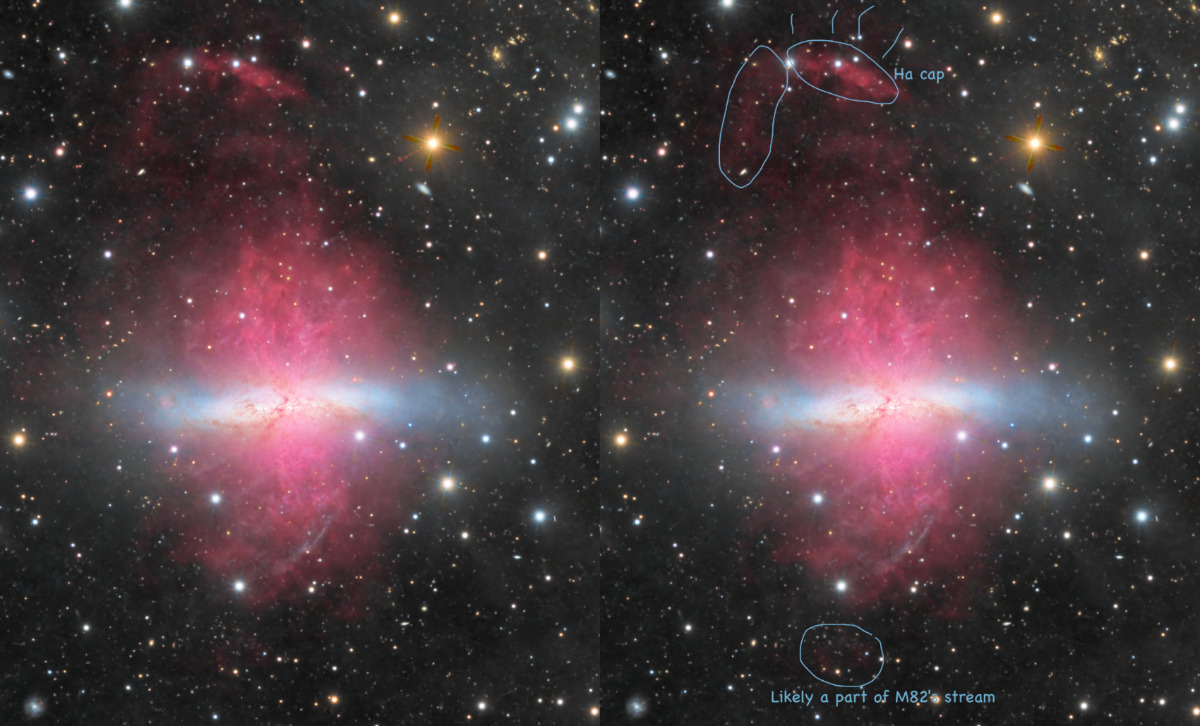
IFN (integrated Flux nebula), which can be referred to as nebulae clouds. This IFN is located in our own galaxy, and is illuminated by the combined energy of all the stars in the Milky Way. It is best observable near the celestial poles, making M81/82’s region ideal for capturing it. However, it is not the easiest to photograph, as you either need super dark skies or a lot of integration time (ideally both) due to it being super dim (around 25 mag/arcsec2). It is mainly composed of dust particles, hydrogen (HI), and carbon monoxide but also various other elements. In this image from Prashant R., who contributed his data for MSGR, the vast span of the IFN out of our frame can be seen. Note that this still is only a tiny portion of what is to be found.
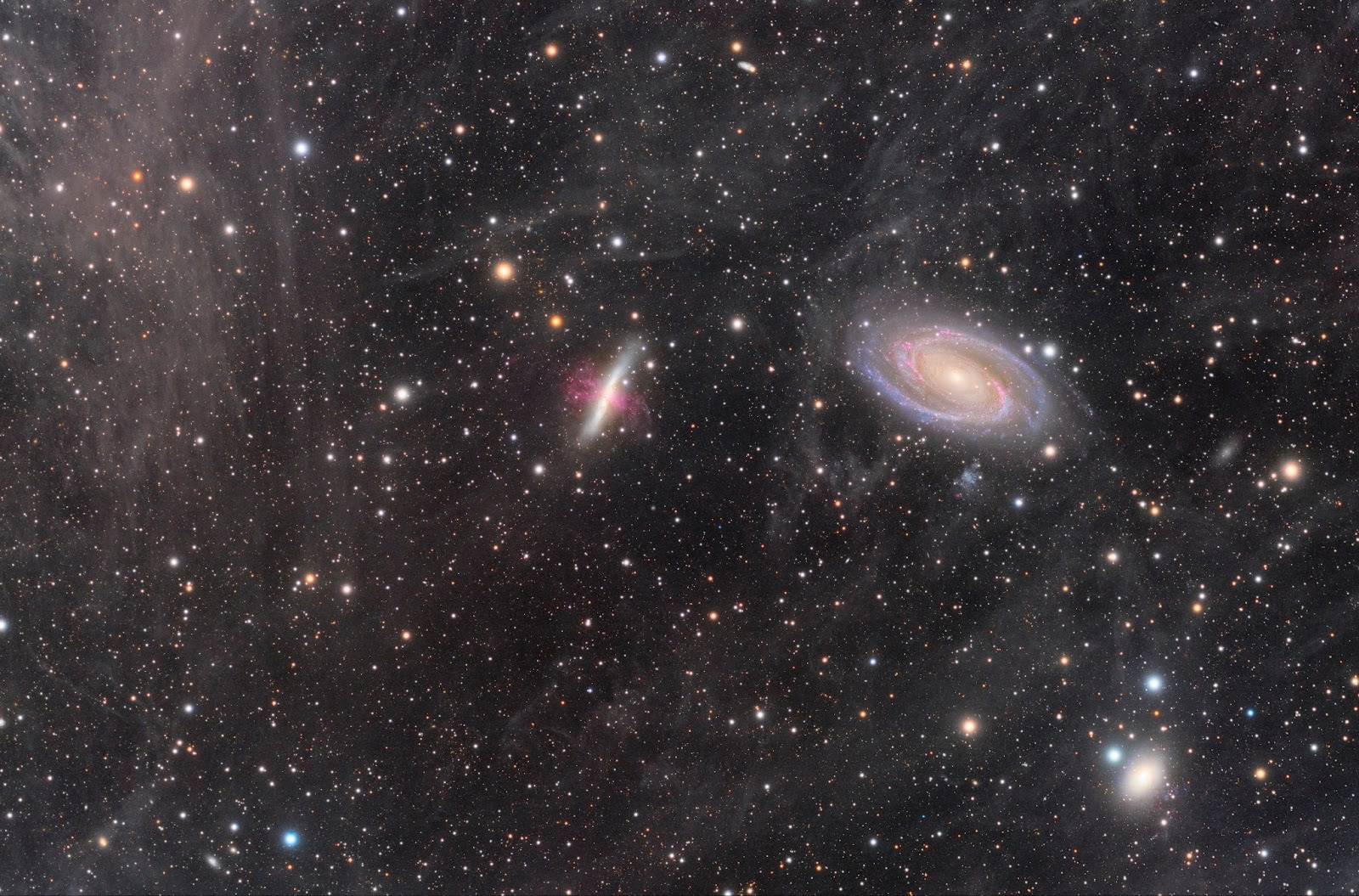
© @Prashant Ranganath - his image shows the vast prominence of IFN in this region (https://www.reddit.com/r/astrophotography/comments/uaokbb/m8182_and_surrounding_ifn_50_hours_of_halrgb/)
The HI blend using VLA’s HI emission observations further highlights the cosmic interaction between the two galaxies (and NGC3077, a galaxy not included in our final FOV). The HI image is basically a map of gravitational interactions between the two galaxies, clearly showing HI bridges that connect the galaxies. Interestingly enough there are clear similarities between the broadband IFN and narrower HI data. Ongoing research suggests two main explanations for this: One explanation would be that the IFN is actually neutral emissions from the HI regions that appear similar to H-alpha. However, this is most likely not the case as the IFN in the region appears to be too widespread. Most likely, the IFN is a mix of true IFN and faint emissions from the stellar streams traced by the HU emissions. However there’s no 100% certain answer to this as of right now.
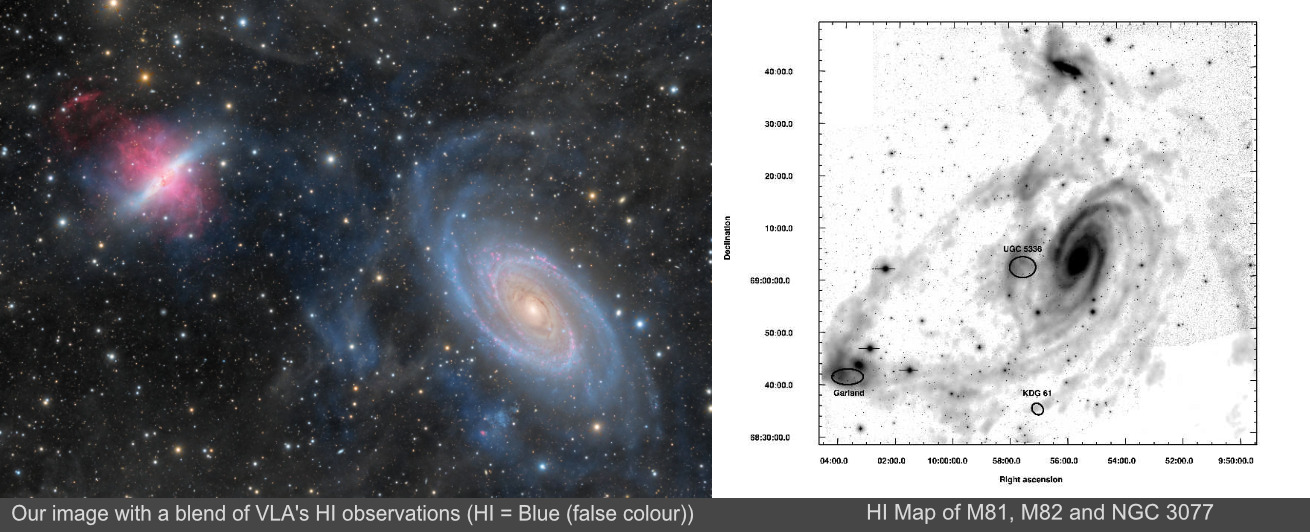
Zoomable, full-resolution image (click on the image):

A blue stream on the south side of the Ha stream. This stream has been revealed in some other deep images as well, but as we went extra deep for this image, the detail in this stream is pretty astonishing. The exact origin of this stream is yet to be exactly determined. Two main explanations are that it is an interaction remnant or a shocked starburst stream, though most likely it is a secondary result of a galactic low-velocity shock caused by interaction with M81. The resulting shock heats and compresses the gas to optimal star-forming conditions, giving the stream its signature blue colour.
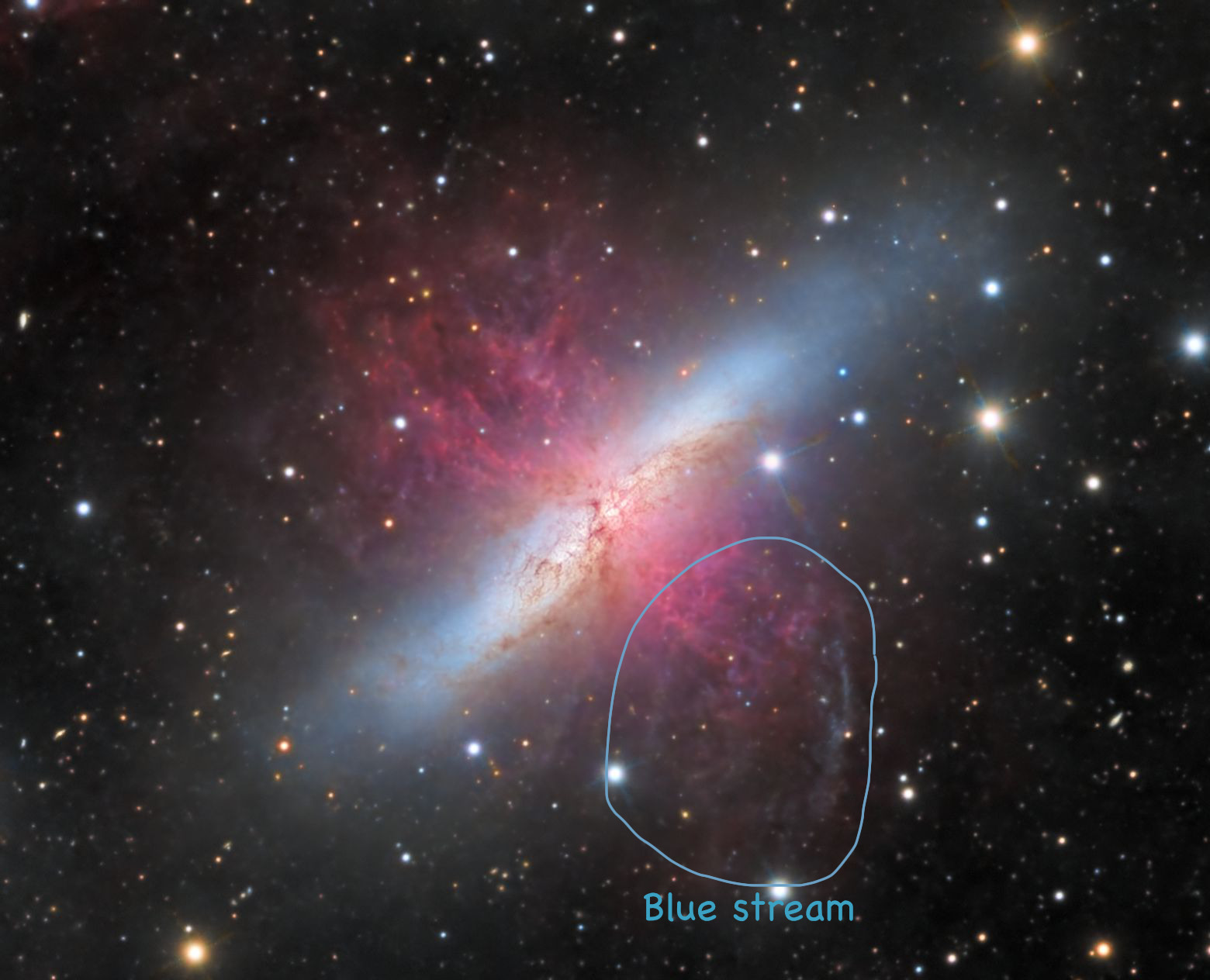
Many fine details in our image, such as galaxy clusters.
Note that parts of this text were inspired by other collaborations on this region, such as the B.A.T’s and one where William was part of last year. For any further questions about the project, feel free to leave a comment!
For a more technical overview of the editing, please refer to Will’s website: https://theastroenthusiast.com/collab-processing/
Integration overview
Here you find a list of integration contribution from all 15 photographers
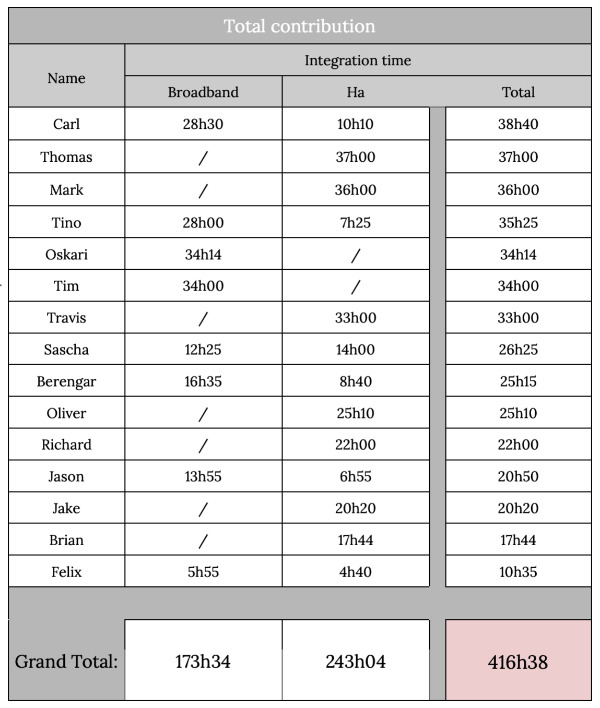
We hope that you enjoy this image!
Text written by Tim @Tim Schaeffer , organizer and co-ordinator of the project and fact checked & proofread by William @William Ostling.
Recommend
About Joyk
Aggregate valuable and interesting links.
Joyk means Joy of geeK